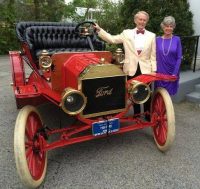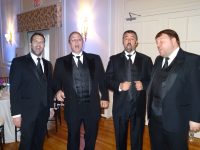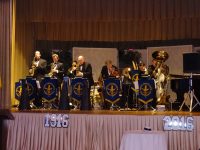White Plains Centennial Ball Reflects on 100 Years of History

There is an old adage that says, “The more things change, the more they stay the same.” While 100 years have passed since White Plains was incorporated as a city and clothing styles, building architecture, automobile design and science and technology have a new look and feel, some of the issues facing White Plains as well as the nation as a whole, are in some ways similar now to they way they were then.
A souvenir flyer created by the White Plains Historical Society representing an important issue in America in 1916 read: “Terrorist Raids on U.S. Soil Must be Stopped!” That issue related to Mexican Revolutionary forces under General Francisco “Pancho” Villa, a former bandit, that crossed the U.S./Mexican border and conducted unprovoked attacks on U.S. towns such as Columbus, N.M., where the flyer said they plundered, raped and killed American civilians, looted banks and burned down buildings. The call to action was to make America’s southern border safe again.

Another souvenir representation said, “Repeal the Infernal, Eternal, Internal Revenue Act of 1913!” According to this flyer, the original act applied to fewer than 4 percent of U.S. citizenry. Those earning below $20,000 annually paid no taxes. The lowest rate at $20,000 or more annually was 1 percent, and the highest rate for $500,000 earners was 6 percent. In 1916 Congress was talking about increasing tax rates and liability levels to include more taxpayers and revenue.
In Westchester, White Plains was considered a hub of activity for business and transportation, then as much as now.

Between 1890 and 1930, the city experienced exponential population growth. According to statistics from the White Plains Historical Society, in 1900, the residential population grew 95.4 percent over the previous 10 years to 7,899. By 1910, the population had grown 90.5 percent, reaching 15,045. Over the next 10 years (during World War I) growth slowed a bit, 39.8 percent to 20,031, but resurged by 1930 to reach 35,830, a growth of 70.4 percent over the previous 10 years.

According to White Plains resident and Historical Society member, Clifford Blau, the White Plains village government was discussing becoming a city at least as early as 1902. In 1908, they were considering annexing the Greenacres section of Scarsdale, as well as West Harrison and part of Greenburgh. In 1910, a bill passed by the New York State legislature to create a city of White Plains was vetoed by then Governor Charles E. Hughes; that included West Harrison and Greenburgh.
“Issues they were dealing with included whether the village should be converted to a city, providing an adequate water supply (despite the recent completion of the second reservoir), the location of the proposed new, electrified train tracks, and prohibition (the citizenry had banned saloons and wholesale liquor dealers in the town of White Plains in November 1907; that ban would be reversed two years later),” Blau said.
In 1916, The City of White Plains was incorporated with 10 square miles.

As the village board held its last meeting on New Year’s Eve 1915, the new city elected officials met at midnight of the New Year. During that meeting certain commissioner positions were determined, but not all members of the new council had been notified of the meeting time and missed out on the selection and appointments, indicating political struggles from the very beginning.
Governor Charles S. Whitman had signed the bill granting the White Plains Charter as a city with the smaller geographic boundary in April 1915 and elections were held in November that year.

Mayor Ffarrington M. Thompson won with a 795-vote margin as mayor of the city. Joseph Allen, Charles H. Dewsnap, Frederick M. Garthwait, Frederick C. McLaughlin, John T. Rehill and William J. Weiss were elected as Councilmen. Dewsnap was elected president of the Council.
Then as now, protecting the city’s watershed was a concern and the Water Commissioner recommended fencing in the entire watershed to protect it from the incursion of waste from nearby farms.

